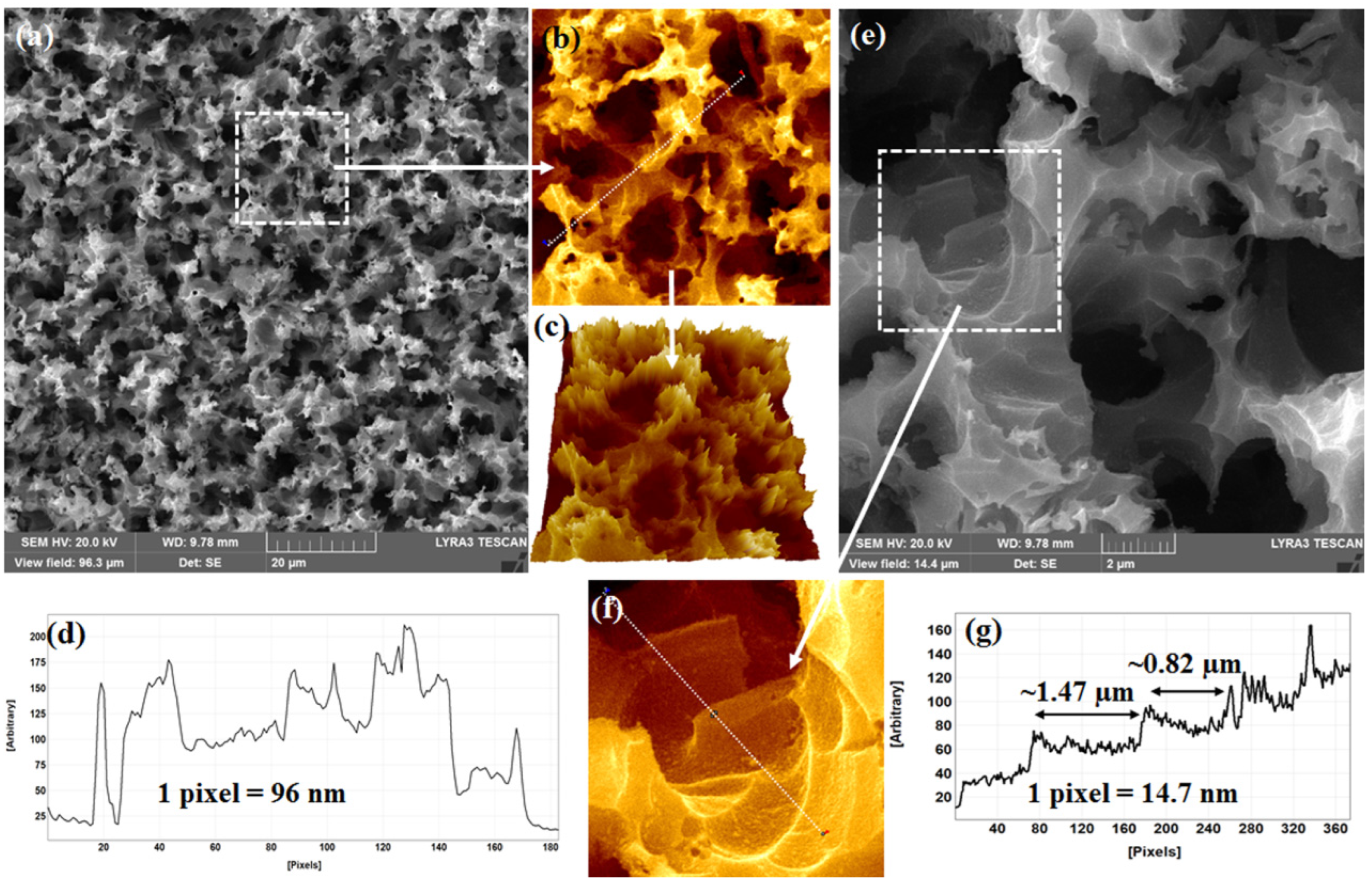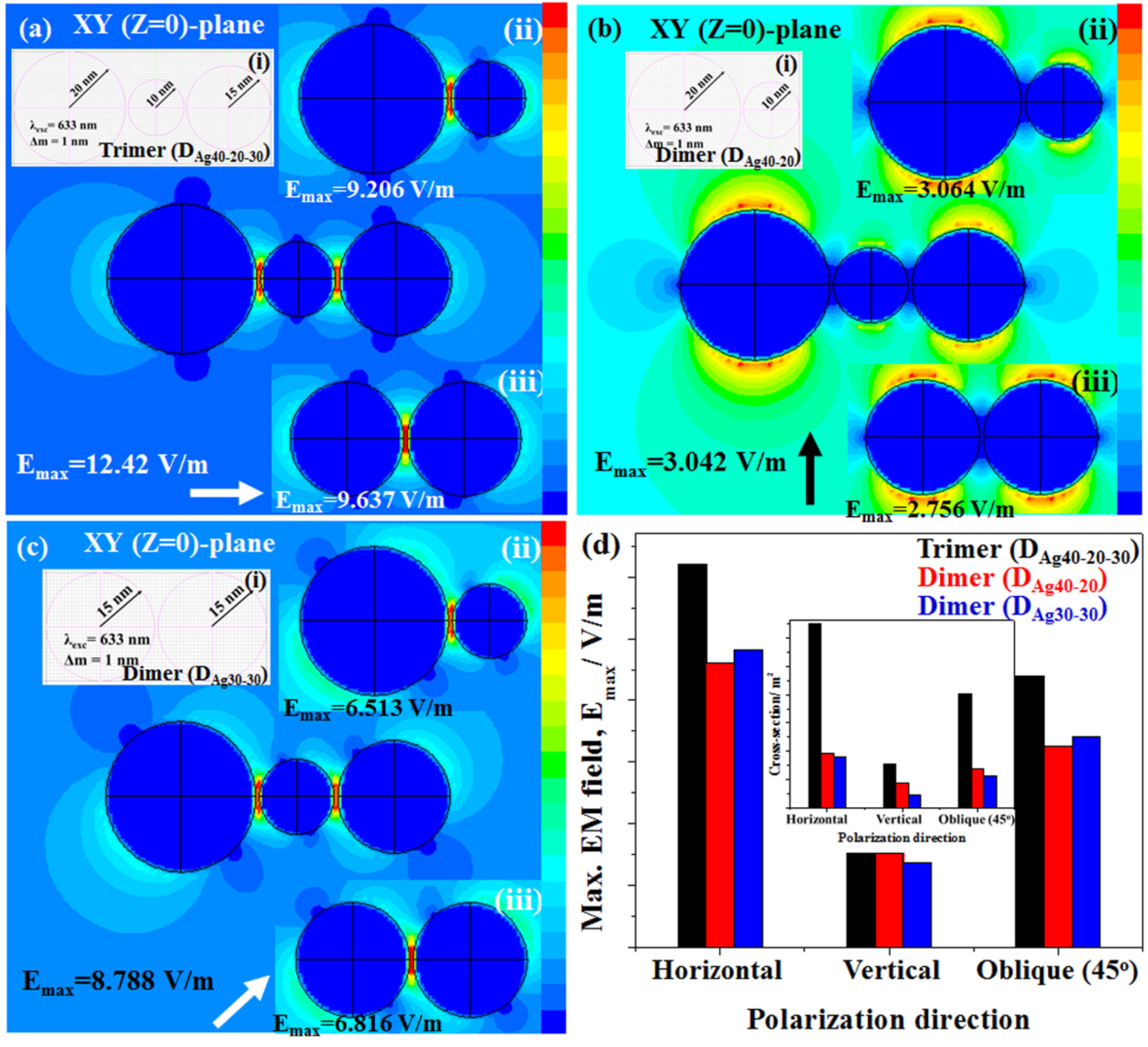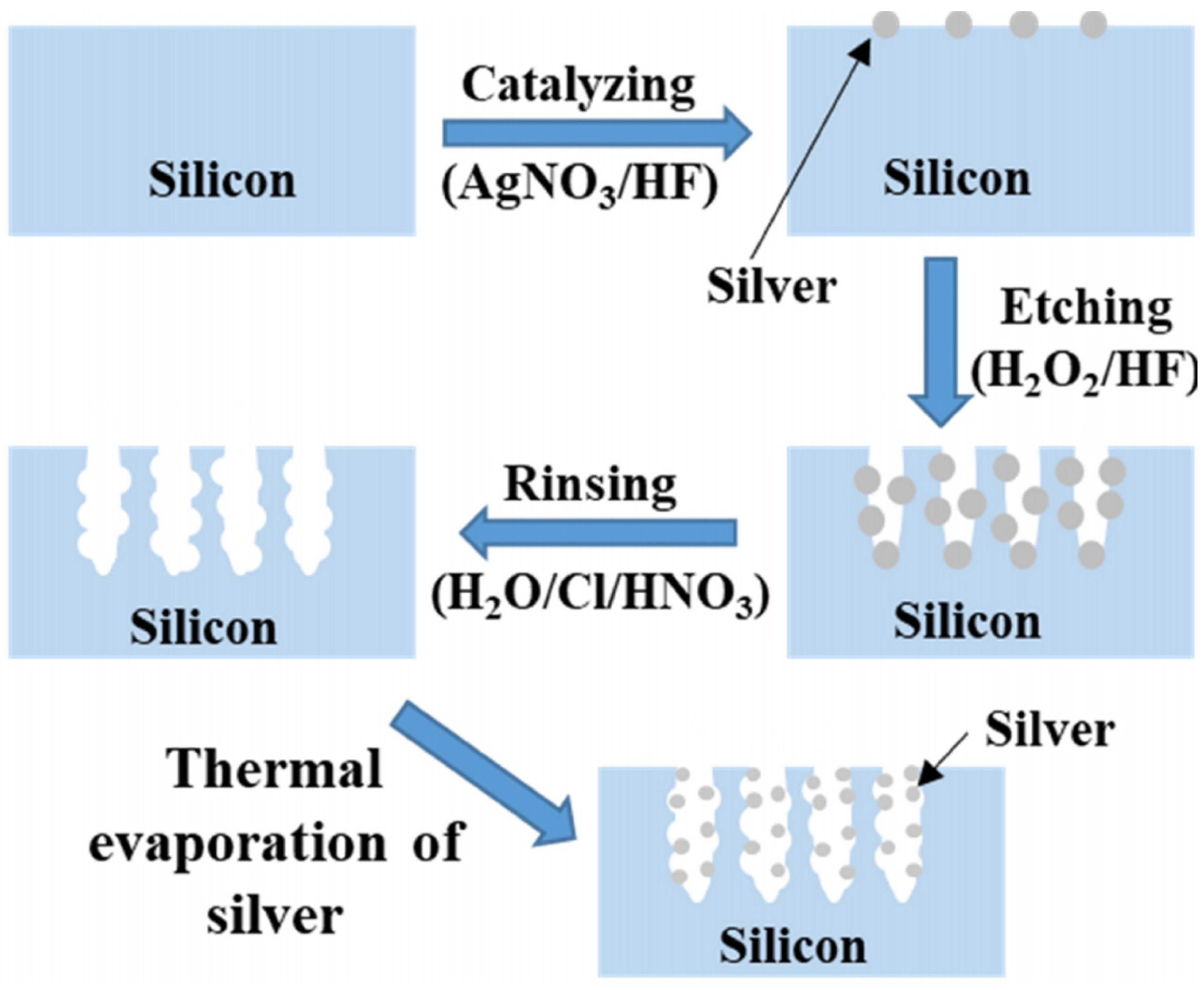Silver-Decorated Silicon Nanostructures: Fabrication and Characterization of Nanoscale Terraces as an Efficient SERS-Active Substrate
Abstract
:1. Introduction
2. Results and Discussion
2.1. Topographic Confirmation
2.2. SERS-Activity
2.3. EM Near-Field Distributions
3. Materials and Methods
3.1. Si-NSs and Ag-NPs-Decorated Terraces in Si-NSs
3.2. SERS Set-Up
3.3. FDTD Simulation
4. Conclusions
Funding
Institutional Review Board Statement
Informed Consent Statement
Data Availability Statement
Acknowledgments
Conflicts of Interest
References
- Xie, L.; Zeng, H.; Zhu, J.; Zhang, Z.; Sun, H.; Xia, W.; Du, Y. State of the art in flexible SERS sensors toward label-free and onsite detection: From design to applications. Nano Res. 2022, 15, 4374–4394. [Google Scholar] [CrossRef]
- Lin, Z.; He, L. Recent advance in SERS techniques for food safety and quality analysis: A brief review. Curr. Opin. Food Sci. 2019, 28, 82–87. [Google Scholar] [CrossRef]
- Bukowska, J.; Piotrowski, P. Surface-enhanced Raman scattering (SERS) in bioscience: A review of application. In Optical Spectroscopy and Computational Methods in Biology and Medicine; Springer: Berlin/Heidelberg, Germany, 2014; pp. 29–59. [Google Scholar]
- Xi, X.; Liang, C. Perspective of future SERS clinical application based on current status of Raman spectroscopy clinical trials. Front. Chem. 2021, 9, 665841. [Google Scholar] [CrossRef] [PubMed]
- Cialla, D.; Pollok, S.; Steinbrücker, C.; Weber, K.; Popp, J. SERS-based detection of biomolecules. Nanophotonics 2014, 3, 383–411. [Google Scholar] [CrossRef] [Green Version]
- Mosier-Boss, P.A. Review on SERS of Bacteria. Biosensors 2017, 7, 51. [Google Scholar] [CrossRef] [Green Version]
- Luo, S.; Sivashanmugan, K.; Liao, J.; Yao, C.; Peng, H. Nanofabricated SERS-active substrates for single-molecule to virus detection in vitro: A review. Biosens. Bioelectron. 2014, 61, 232–240. [Google Scholar] [CrossRef]
- Radziuk, D.; Moehwald, H. Prospects for plasmonic hot spots in single molecule SERS towards the chemical imaging of live cells. Phys. Chem. Chem. Phys. 2015, 17, 21072–21093. [Google Scholar] [CrossRef] [Green Version]
- Moreno, V.; Adnane, A.; Salghi, R.; Zougagh, M.; Ríos, Á. Nanostructured hybrid surface enhancement Raman scattering substrate for the rapid determination of sulfapyridine in milk samples. Talanta 2019, 194, 357–362. [Google Scholar] [CrossRef]
- Yu, Y.; Xiao, T.; Wu, Y.; Li, W.; Zeng, Q.; Long, L.; Li, Z. Roadmap for single-molecule surface-enhanced Raman spectroscopy. Adv. Photonics 2020, 2, 014002. [Google Scholar] [CrossRef] [Green Version]
- Fleischmann, M.; Hendra, P.J.; McQuillan, A.J. Raman spectra of pyridine adsorbed at a silver electrode. Chem. Phys. Lett. 1974, 26, 163–166. [Google Scholar] [CrossRef]
- Jeanmaire, D.L.; van Duyne, R.P. Surface Raman spectroelectrochemistry: Part I. Heterocyclic, aromatic, and aliphatic amines adsorbed on the anodized silver electrode. J. Electroanal. Chem. Interfacial Electrochem. 1977, 84, 1–20. [Google Scholar] [CrossRef]
- MAlbrecht, G.; Creighton, J.A. Anomalously intense Raman spectra of pyridine at a silver electrode. J. Am. Chem. Soc. 1977, 99, 5215–5217. [Google Scholar] [CrossRef]
- Moskovits, M. Surface roughness and the enhanced intensity of Raman scattering by molecules adsorbed on metals. J. Chem. Phys. 1978, 69, 4159–4161. [Google Scholar] [CrossRef]
- Ding, S.; You, E.; Tian, Z.; Moskovits, M. Electromagnetic theories of surface-enhanced Raman spectroscopy. Chem. Soc. Rev. 2017, 46, 4042–4076. [Google Scholar] [CrossRef]
- Wang, Z.; Cai, K.; Lu, Y.; Wu, H.; Li, Y.; Zhou, Q. Insight into the working wavelength of hotspot effects generated by popular nanostructures. Nanotechnol. Rev. 2019, 8, 24–34. [Google Scholar] [CrossRef]
- Xia, M.; Zhang, P.; Qiao, K.; Bai, Y.; Xie, Y. Coupling SPP with LSPR for enhanced field confinement: A simulation study. J. Phys. Chem. C 2016, 120, 527–533. [Google Scholar] [CrossRef] [Green Version]
- Hossain, M.K.; Kitahama, Y.; Ozaki, Y. Half-raspberry-like bimetallic nanoassembly: Interstitial dependent correlated surface plasmon resonances and surface-enhanced Raman spectroscopy. Phys. Chem. Chem. Phys. 2021, 23, 23875–23885. [Google Scholar] [CrossRef]
- Hossain, M.K.; Drmosh, Q.A.; Arifuzzaman, M. Silver nanoparticles, nanoneedles and nanorings: Impact of electromagnetic near-field on surface-enhanced Raman scattering. Phys. Chem. Chem. Phys. 2022, 24, 8787–8799. [Google Scholar] [CrossRef]
- Hossain, M.K. Nanoassembly of gold nanoparticles: An active substrate for size-dependent surface-enhanced Raman scattering. Spectrochim. Acta Part A Mol. Biomol. Spectrosc. 2020, 242, 118759. [Google Scholar] [CrossRef]
- Imura, K.; Okamoto, H.; Hossain, M.K.; Kitajima, M. Visualization of localized intense optical fields in single gold−nanoparticle assemblies and ultrasensitive Raman active sites. Nano Lett. 2006, 6, 2173–2176. [Google Scholar] [CrossRef]
- Hossain, M.K.; Willmott, G.R.; Etchegoin, P.G.; Blaikie, R.J.; Tallon, J.L. Tunable SERS using gold nanoaggregates on an elastomeric substrate. Nanoscale 2013, 5, 8945–8950. [Google Scholar] [CrossRef] [PubMed]
- Hossain, M.K.; Kitajima, M.; Imura, K.; Okamoto, H. Interstitial-dependent enhanced photoluminescence: A near-field microscopy on single spheroid to dimer, tetramer, and few particles gold nanoassembly. J. Phys. Chem. C 2017, 121, 2344–2354. [Google Scholar] [CrossRef]
- Hossain, M.K.; Kitahama, Y.; Biju, V.; Itoh, T.; Kaneko, T.; Ozaki, Y. Surface plasmon excitation and surface-enhanced Raman scattering using two-dimensionally close-packed gold nanoparticles. J. Phys. Chem. C 2009, 113, 11689–11694. [Google Scholar] [CrossRef]
- Hossain, M.K.; Shimada, T.; Kitajima, M.; Imura, K.; Okamoto, H. Near-field Raman imaging and electromagnetic field confinement in the self-assembled monolayer array of gold nanoparticles. Langmuir 2008, 24, 9241–9244. [Google Scholar] [CrossRef] [PubMed]
- Li, J.; Yan, H.; Tan, X.; Lu, Z.; Han, H. Cauliflower-inspired 3D SERS substrate for multiple mycotoxins detection. Anal. Chem. 2019, 91, 3885–3892. [Google Scholar] [CrossRef]
- Hossain, M.K.; Drmosh, Q.A.; Mohamedkhair, A.K. Plasmonic Pollen Grain Nanostructures: A Three-Dimensional Surface-Enhanced Raman Scattering (SERS)-Active Substrate. Chem. Asian J. 2021, 16, 1807–1819. [Google Scholar] [CrossRef]
- Zhang, Q.; Lee, Y.H.; Phang, I.Y.; Lee, C.K.; Ling, X.Y. Hierarchical 3D SERS Substrates Fabricated by Integrating Photolithographic Microstructures and Self-Assembly of Silver Nanoparticles. Small 2014, 10, 2703–2711. [Google Scholar] [CrossRef]
- Xu, J.; Li, C.; Si, H.; Zhao, X.; Wang, L.; Jiang, S.; Wei, D.; Yu, J.; Xiu, X.; Zhang, C. 3D SERS substrate based on Au-Ag bi-metal nanoparticles/MoS 2 hybrid with pyramid structure. Opt. Express 2018, 26, 21546–21557. [Google Scholar] [CrossRef]
- Qian, Y.; Meng, G.; Huang, Q.; Zhu, C.; Huang, Z.; Sun, K.; Chen, B. Flexible membranes of Ag-nanosheet-grafted polyamide-nanofibers as effective 3D SERS substrates. Nanoscale 2014, 6, 4781–4788. [Google Scholar] [CrossRef] [Green Version]
- Lee, S.Y.; Kim, S.; Kim, M.P.; Jeon, H.C.; Kang, H.; Kim, H.J.; Kim, B.J.; Yang, S. Freestanding and arrayed nanoporous microcylinders for highly active 3D SERS substrate. Chem. Mater. 2013, 25, 2421–2426. [Google Scholar] [CrossRef]
- Lu, R.; Sha, J.; Xia, W.; Fang, Y.; Gu, L.; Wang, Y. A 3D-SERS substrate with high stability: Silicon nanowire arrays decorated by silver nanoparticles. CrystEngComm 2013, 15, 6207–6212. [Google Scholar] [CrossRef]
- Kim, J.; Sim, K.; Cha, S.; Oh, J.; Nam, J. Single-particle analysis on plasmonic nanogap systems for quantitative SERS. J. Raman Spectrosc. 2021, 52, 375–385. [Google Scholar] [CrossRef]
- Dahlin, A.B. Sensing applications based on plasmonic nanopores: The hole story. Analyst 2015, 140, 4748–4759. [Google Scholar] [CrossRef]
- Guan, Y.; Wang, Z.; Gu, P.; Wang, Y.; Zhang, W.; Zhang, G. An in situ SERS study of plasmonic nanochemistry based on bifunctional hedgehog-like arrays. Nanoscale 2019, 11, 9422–9428. [Google Scholar] [CrossRef]
- Verma, A.K.; Soni, R.K. Multi-spiked silver stars for ultrasensitive and multiplexed SERS detection of analytes. J. Phys. D Appl. Phys. 2021, 54, 475107. [Google Scholar] [CrossRef]
- Hossain, M.K.; Mukhaimer, A.W.; Al-Jabari, M. Fabrication and characterizations of arbitrary-shaped silver nanoparticles for surface-enhanced fluorescence microscopy. J. Nanoparticle Res. 2021, 23, 89. [Google Scholar] [CrossRef]
- Serrano-Montes, A.B.; de Aberasturi, D.J.; Langer, J.; Giner-Casares, J.J.; Scarabelli, L.; Herrero, A.; Liz-Marzán, L.M. A general method for solvent exchange of plasmonic nanoparticles and self-assembly into SERS-active monolayers. Langmuir 2015, 31, 9205–9213. [Google Scholar] [CrossRef] [Green Version]
- Salhi, B.; Hossain, M.K.; Mukhaimer, A.W.; Al-Sulaiman, F.A. Nanowires: A new pathway to nanotechnology-based applications. J. Electroceramics 2016, 37, 34–49. [Google Scholar] [CrossRef]
- Mokkapati, S.; Jagadish, C. Review on photonic properties of nanowires for photovoltaics. Opt. Express 2016, 24, 17345–17358. [Google Scholar] [CrossRef] [Green Version]
- Quan, L.N.; Kang, J.; Ning, C.; Yang, P. Nanowires for photonics. Chem. Rev. 2019, 119, 9153–9169. [Google Scholar] [CrossRef]
- Piccione, B.; Aspetti, C.O.; Cho, C.; Agarwal, R. Tailoring light–matter coupling in semiconductor and hybrid-plasmonic nanowires. Rep. Prog. Phys. 2014, 77, 086401. [Google Scholar] [CrossRef] [PubMed] [Green Version]
- Li, Y.; Dykes, J.; Gilliam, T.; Chopra, N. A new heterostructured SERS substrate: Free-standing silicon nanowires decorated with graphene-encapsulated gold nanoparticles. Nanoscale 2017, 9, 5263–5272. [Google Scholar] [CrossRef] [PubMed] [Green Version]
- Moeinian, A.; Gur, F.N.; Gonzalez-Torres, J.; Zhou, L.; Murugesan, V.D.; Dashtestani, A.D.; Guo, H.; Schmidt, T.L.; Strehle, S. Highly localized SERS measurements using single silicon nanowires decorated with DNA origami-based SERS probe. Nano Lett. 2019, 19, 1061–1066. [Google Scholar] [CrossRef] [PubMed]
- Nam, W.; Ren, X.; Tali, S.A.S.; Ghassemi, P.; Kim, I.; Agah, M.; Zhou, W. Refractive-index-insensitive nanolaminated SERS substrates for label-free raman profiling and classification of living cancer cells. Nano Lett. 2019, 19, 7273–7281. [Google Scholar] [CrossRef] [PubMed]
- Bai, S.; Du, Y.; Wang, C.; Wu, J.; Sugioka, K. Reusable surface-enhanced Raman spectroscopy substrates made of silicon nanowire array coated with silver nanoparticles fabricated by metal-assisted chemical etching and photonic reduction. Nanomaterials 2019, 9, 1531. [Google Scholar] [CrossRef] [Green Version]
- Lin, D.; Wu, Z.; Li, S.; Zhao, W.; Ma, C.; Wang, J.; Jiang, Z.; Zhong, Z.; Zheng, Y.; Yang, X. Large-area Au-nanoparticle-functionalized Si nanorod arrays for spatially uniform surface-enhanced Raman spectroscopy. ACS Nano 2017, 11, 1478–1487. [Google Scholar] [CrossRef]
- Huang, J.; Zhao, Y.; Zhang, X.; He, L.; Wong, T.; Chui, Y.; Zhang, W.; Lee, S. Ordered Ag/Si nanowires array: Wide-range surface-enhanced Raman spectroscopy for reproducible biomolecule detection. Nano Lett. 2013, 13, 5039–5045. [Google Scholar] [CrossRef]
- Faro, L.; José, M.; D’Andrea, C.; Leonardi, A.A.; Morganti, D.; Irrera, A.; Fazio, B. Fractal silver dendrites as 3D SERS platform for highly sensitive detection of biomolecules in hydration conditions. Nanomaterials 2019, 9, 1630. [Google Scholar] [CrossRef] [Green Version]
- Schmidt, M.S.; Hübner, J.; Boisen, A. Large area fabrication of leaning silicon nanopillars for surface enhanced Raman spectroscopy. Adv. Mater. 2012, 24, OP11–OP18. [Google Scholar] [CrossRef]
- Hossain, M.K. Surface-enhanced Raman scattering: A technique of choice for molecular detection. Mater. Sci. Forum 2013, 754, 143–169. [Google Scholar] [CrossRef]
- Hossain, M.K.; Kitahama, Y.; Huang, G.G.; Han, X.; Ozaki, Y. Surface-enhanced Raman scattering: Realization of localized surface plasmon resonance using unique substrates and methods. Anal. Bioanal. Chem. 2009, 394, 1747–1760. [Google Scholar] [CrossRef]
- Hossain, M.K.; Ozaki, Y. Surface-enhanced Raman scattering: Facts and inline trends. Curr. Sci. 2009, 97, 00113891. [Google Scholar]
- Le Ru, E.; Etchegoin, P. Principles of Surface-Enhanced Raman Spectroscopy: And Related Plasmonic Effects; Elsevier: Amsterdam, The Netherlands, 2008. [Google Scholar]
- Itoh, T.; Biju, V.; Ishikawa, M.; Kikkawa, Y.; Hashimoto, K.; Ikehata, A.; Ozaki, Y. Surface-enhanced resonance Raman scattering and background light emission coupled with plasmon of single Ag nanoaggregates. J. Chem. Phys. 2006, 124, 134708. [Google Scholar] [CrossRef]
- Pettinger, B. Light scattering by adsorbates at Ag particles: Quantum-mechanical approach for energy transfer induced interfacial optical processes involving surface plasmons, multipoles, and electron-hole pairs. J. Chem. Phys. 1986, 85, 7442–7451. [Google Scholar] [CrossRef]
- Itoh, T.; Yoshida, K.; Biju, V.; Kikkawa, Y.; Ishikawa, M.; Ozaki, Y. Second enhancement in surface-enhanced resonance Raman scattering revealed by an analysis of anti-Stokes and Stokes Raman spectra. Phys. Rev. B 2007, 76, 085405. [Google Scholar] [CrossRef]
- Hossain, M.K.; Salhi, B.; Mukhaimar, A. Fabrication and Spectral Characteristics of Silicon Nanowires for Efficient Solar Energy Harvesting. Plasmonics 2021, 16, 1–8. [Google Scholar] [CrossRef]
- Haruna, K.; Saleh, T.A.; Hossain, M.K.; Al-Saadi, A.A. Hydroxylamine reduced silver colloid for naphthalene and phenanthrene detection using surface-enhanced Raman spectroscopy. Chem. Eng. J. 2016, 304, 141–148. [Google Scholar] [CrossRef]






| SERS Band of R6G (cm−1) | Band Assignments | EF |
|---|---|---|
| 610 | C−C ring bending (in-plane) in phenyl rings | ~1.71 × 106 |
| 769 | C−H bending (out-of-plane) | ~1.17 × 106 |
| 1120 | C-H bending (in plane) xanthene/phenyl rings | ~3.70 × 106 |
| 1182 | C−H bending (in-plane) in xanthene ring | ~7.20 × 105 |
| 1310 | C-C Hybrid stretching in xanthene/phenyl rings and NHC2H5 group | ~3.93 × 106 |
| 1361 | C−C stretching in xanthene ring | ~8.08 × 105 |
| 1508 | C−C stretching in xanthene ring | ~4.28 × 106 |
| 1571 | C-C stretching in phenyl ring | ~7.55 × 105 |
| 1595 | C−C stretching in phenyl ring | ~4.36 × 105 |
| 1648 | C−C stretching in xanthene ring | ~3.81 × 105 |
Disclaimer/Publisher’s Note: The statements, opinions and data contained in all publications are solely those of the individual author(s) and contributor(s) and not of MDPI and/or the editor(s). MDPI and/or the editor(s) disclaim responsibility for any injury to people or property resulting from any ideas, methods, instructions or products referred to in the content. |
© 2022 by the author. Licensee MDPI, Basel, Switzerland. This article is an open access article distributed under the terms and conditions of the Creative Commons Attribution (CC BY) license (https://creativecommons.org/licenses/by/4.0/).
Share and Cite
Hossain, M.K. Silver-Decorated Silicon Nanostructures: Fabrication and Characterization of Nanoscale Terraces as an Efficient SERS-Active Substrate. Int. J. Mol. Sci. 2023, 24, 106. https://doi.org/10.3390/ijms24010106
Hossain MK. Silver-Decorated Silicon Nanostructures: Fabrication and Characterization of Nanoscale Terraces as an Efficient SERS-Active Substrate. International Journal of Molecular Sciences. 2023; 24(1):106. https://doi.org/10.3390/ijms24010106
Chicago/Turabian StyleHossain, Mohammad Kamal. 2023. "Silver-Decorated Silicon Nanostructures: Fabrication and Characterization of Nanoscale Terraces as an Efficient SERS-Active Substrate" International Journal of Molecular Sciences 24, no. 1: 106. https://doi.org/10.3390/ijms24010106





